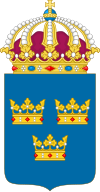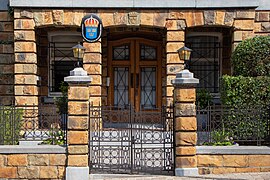Embassy of Sweden in Bangkok is Sweden's diplomatic mission in Thailand. The ambassador is also accredited to Cambodia, Laos and Myanmar. Sweden also has four honorary consulates in Thailand: in Phuket, Pattaya, Chiang Mai and Hua Hin.
The Embassy of Sweden in Rome is Sweden's diplomatic mission in Italy. The Swedish embassy in Rome dates back to the 1450s and is thus the oldest in the world. Birger Månsson was sent to Rome because the Swedish government wanted to improve the relationship with the Pope. Today, the embassy is also a representation at the UN agencies in Rome: Food and Agriculture Organization (FAO), World Food Programme (WFP) and the International Fund for Agricultural Development (IFAD). The ambassador has a dual accreditation in San Marino.
The Embassy of Sweden in Mexico City is Sweden's diplomatic mission in Mexico. The mission of the embassy is to represent Swedish interests in Mexico, as well as to strengthen bilateral relations within the governmental, commercial, business, academic, cultural and civil society spheres, with a particular emphasis on cooperation for sustainable development.
The Embassy of Sweden in New Delhi is Sweden's diplomatic mission in India. The embassy is headed by the ambassador of Sweden to India. The embassy is situated in Chanakyapuri, the diplomatic enclave of New Delhi, where most of the embassies in India are located. The Swedish embassy is responsible for the honorary consulates in India, located in Kolkata and Chennai, and the Swedish consulate general in Mumbai. The ambassador of New Delhi is also accredited to Sri Lanka, Nepal, Bhutan and Maldives.

The Consulate General of Sweden is the diplomatic mission of Sweden in New York City. It is located at One Dag Hammarskjöld Plaza in Turtle Bay, Manhattan, near the headquarters of the United Nations.
The Embassy of Sweden in Ottawa is Sweden's diplomatic mission in Canada. The Swedish embassy in Canada represents the Swedish government in Canada and The Bahamas. The embassy is located in ByWard Market in the downtown core of the capital of Ottawa. Ambassador since 2019 is Urban Ahlin. Sweden also has nine honorary consulates in Canada.
The Embassy of Sweden in Algiers is Sweden's diplomatic mission in Algeria. The first Swedish ambassador was accredited to Algiers in 1963. The ambassador since 2021 is Björn Häggmark.

Nils Ivar (Nils-Ivar) Carlborg was a Swedish Army officer. He started the paratrooper training in Sweden and founded the Swedish Army Paratroop School of which he was its first commander (1952–1953). He later served as head of the Military Academy Karlberg (1964–1969) and as commander of Stockholm Defence District (1969–1973) and as the Commandant of Stockholm (1969–1973).
The Embassy of Sweden in Buenos Aires is Sweden's diplomatic mission in Argentina. The ambassador since 2019 is Anders Carlsson. The embassy is located in Puerto Madero and its staff consists of three people from the Ministry for Foreign Affairs and six local employees. In addition to Argentina, the embassy's area of activity also includes Paraguay and Uruguay. The embassy's activities include trade promotion, culture and Sweden promotion, migration and consular affairs, as well as reporting on politics, human rights and the economy.
The Embassy of Sweden in Tokyo is Sweden's diplomatic mission in Japan. The mission was opened in 1906. It's located in the Roppongi district in Minato, Tokyo since 1959. The current embassy building was inaugurated in 1991. The ambassador since 2019 is Pereric Högberg. The ambassador has a dual accreditation to Marshall Islands, the Federated States of Micronesia and Palau.
The Embassy of Sweden in Pretoria is Sweden's diplomatic mission in South Africa. The Swedish embassy in South Africa represents the Swedish government in South Africa, Botswana, Namibia and Lesotho. The embassy is located in the suburb of Hatfield in the capital of Pretoria. The ambassador since 2020 is Håkan Juholt.

The Embassy of Sweden in Lima was Sweden's diplomatic mission in Peru. Diplomatic relations between Peru and Sweden were established in 1930 and the embassy opened the following year. It was closed in 2001 and reopened in 2016, only to close again in 2022. Since then, the Swedish ambassador in Santiago is also accredited to Lima.
The Embassy of Sweden in Dublin is Sweden's diplomatic mission in Ireland. When Ireland became independent, Sweden was one of the countries that early established diplomatic relations with Ireland. The embassy has its origins in the legation that was opened in 1946, which in turn has its origins in the Swedish consulate that was opened in 1926. The embassy closed in 2010 and reopened in 2023.
The Embassy of Sweden in Beijing is Sweden's diplomatic mission in China. The embassy's task is to represent Sweden, the Swedish government in China and to promote Swedish interests. Trade promotion and development cooperation are other tasks for the embassy, as well as press and culture issues and migration and consular services. The embassy's sphere of responsibility includes Mongolia. The ambassador has a dual accreditation to Ulaanbaatar.
The Consulate General of Sweden, Los Angeles was the diplomatic mission of Sweden in Los Angeles between 1980 and 1995, as well as between 1998 and 2009. The consulate general had its origins in the honorary vice consulate opened in 1910, which was transformed into an honorary consulate in 1955 and an honorary consulate general in 1969. The main tasks of the consulate general were to disseminate information about Sweden and Swedish collaboration opportunities, promote business activities through various events, and handle consular matters and assistance to Swedish citizens in the western United States.
The Consulate General of Sweden, Minneapolis was the diplomatic mission of Sweden in Minneapolis between 1963 and 1989. The consulate originated from the honorary vice consulate opened in 1908, which was converted into a consulate in 1934 and into a consulate general in 1963. Along with those in New York City, San Francisco, Montreal, Chicago, and Houston, the consulate belonged to the so-called "heritage consulates" due to the large number of inheritance cases it handled.
The Consulate General of Sweden, Chicago was the diplomatic mission of Sweden in Chicago between 1943 and 1993. The consulate general originated from the honorary vice consulate opened in 1852, which was converted into an honorary consulate in 1908, and into a consulate in 1913 and finally into a consulate general in 1943. The consulate general tasks was to advance the interests of Sweden, and to serve and protect Swedes in Chicago and different states in the Midwestern United States. Along with those in Minneapolis, New York City, San Francisco, Montreal, and Houston, the consulate general belonged to the so-called "heritage consulates" due to the large number of inheritance cases it handled.
The Consulate General of Sweden, Montreal was the diplomatic mission of Sweden in Montreal between 1916 and 1993. The consulate general originated from the consulate opened in 1906, which was converted into a consulate general in 1916. The consulate general tasks was to advance the interests of Sweden, and to serve and protect Swedes in Montreal and in different provinces and territories of Canada. Along with those in Chicago, Houston, Minneapolis, New York City, and San Francisco, the consulate general belonged to the so-called "heritage consulates" due to the large number of inheritance cases it handled.
The Consulate General of Sweden, London was the diplomatic mission of Sweden in London between 1859 and 1973. The consulate general originated from the consulate opened in 1722, which was converted into a consulate general in 1850. The tasks of the consulate general included consular services, promotion of trade relations, cultural and political relations, matters concerning the maritime industry, and more.
The Embassy of Sweden, The Hague is the diplomatic mission of Sweden in The Hague. The Netherlands is the first country with which Sweden exchanged permanent ambassadors, a relationship established in 1614. The embassy's primary role is to monitor, represent, and advance Swedish interests within the Netherlands and international organizations based in The Hague. Its responsibilities include providing services to Swedish authorities, businesses, organizations, and citizens. The embassy regularly reports to the Ministry for Foreign Affairs in Stockholm, offering insights into political and economic developments, as well as the country's stance on global events. A key focus is promoting Swedish economic interests by aiding Swedish companies and attracting foreign investments to Sweden, collaborating closely with Business Sweden in The Hague and the Swedish Chamber of Commerce in Amsterdam. Additionally, the embassy handles consular matters. It also engages in promoting Sweden through seminars, exhibitions, and cultural events.









